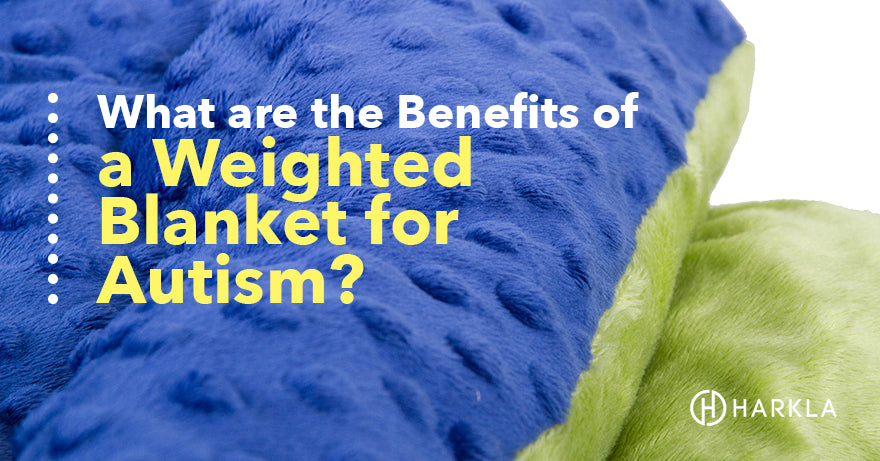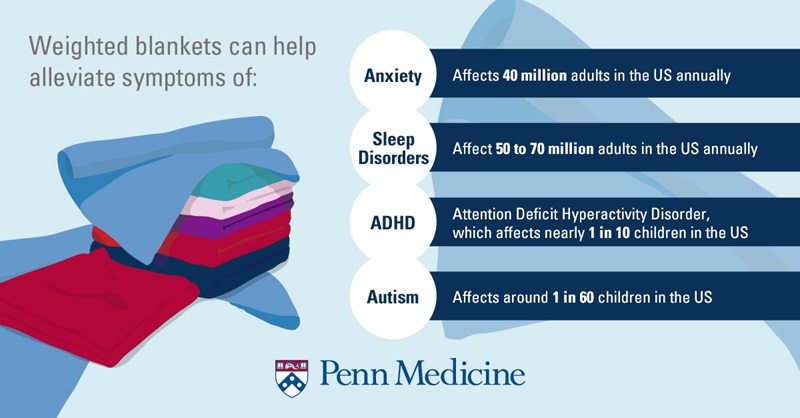Imagine wrapping yourself in a hug that instantly calms your senses. That’s exactly what a weighted blanket can do, especially for individuals with autism.
You might have heard of these specially designed blankets, but do you know how they actually work? If you’re curious about how a simple change in your bedding can make a significant difference, you’re in the right place. Weighted blankets have been creating a buzz for their potential benefits in autism therapy, and it’s time you discovered why.
This article will unravel the science and the magic behind these comforting tools, revealing how they can transform restless nights into peaceful slumbers. Stay with us as we explore the soothing power of weighted blankets and how they might just be the missing piece in achieving a more relaxed and balanced life for those with autism.
Sensory Processing In Autism
Weighted blankets help individuals with autism by providing deep pressure stimulation. This calming effect can reduce anxiety and improve sleep. Many find comfort and a sense of security under their gentle weight.
Understanding sensory processing in autism is crucial for caregivers and individuals who live with autism. Sensory processing refers to how our brain interprets and responds to information from our senses. People with autism often experience sensory information differently, which can lead to challenges in daily life. Some may find certain sounds overwhelming, while others might be sensitive to light or touch. This sensitivity can make everyday environments feel chaotic and stressful. ###Challenges Faced
Individuals with autism may struggle with sensory overload. Imagine being in a room where every sound feels amplified, every light too bright, and every touch too intense. This can lead to anxiety, meltdowns, or withdrawal. Some may seek sensory input, like the child who constantly needs to touch different textures. Others might avoid it, perhaps refusing hugs because the sensation is too much. Navigating these challenges requires understanding and patience. ###Role Of Deep Pressure Stimulation
Deep pressure stimulation (DPS) can provide a calming effect. Weighted blankets use DPS to help soothe the nervous system. The gentle pressure mimics a comforting hug, helping to reduce anxiety and promote relaxation. Think about how a tight embrace from a loved one can make you feel safe. For those with autism, a weighted blanket can offer a similar sense of security. It can help them fall asleep faster, stay asleep longer, and feel more grounded during the day. Have you ever felt instantly calmer when someone you trust places a reassuring hand on your shoulder? Weighted blankets aim to replicate this feeling, offering a practical solution to sensory processing challenges. By understanding and addressing sensory needs, you can create a more comfortable and supportive environment for those with autism. How might a weighted blanket change the way your loved one experiences their world?
Credit: karmara.co.uk
What Are Weighted Blankets?
Weighted blankets are therapeutic tools designed to provide comfort. They are especially beneficial for individuals with autism. These blankets use deep touch pressure stimulation. This technique helps calm the nervous system. Many people find them soothing and relaxing.
Design And Materials
Weighted blankets are crafted with care. They often use soft, breathable fabrics. Inside, they contain tiny beads or pellets. These materials give the blanket its weight. The outer layer is usually washable for convenience. Some blankets have removable covers. This feature makes cleaning easier. Manufacturers use hypoallergenic materials. This ensures safety for users with sensitivities.
Weight And Distribution
The weight of these blankets varies. It typically ranges from 5 to 30 pounds. The ideal weight is about 10% of the user’s body weight. Proper weight distribution is crucial. It ensures even pressure across the body. This uniform pressure mimics a gentle hug. It helps reduce stress and anxiety. The distribution also enhances comfort. Users often report better sleep quality.
Calming Effects Of Weighted Blankets
Weighted blankets are known for their calming effects on individuals with autism. These blankets apply gentle pressure, simulating a comforting hug. This feeling can promote relaxation and emotional security, crucial for those with autism.
Impact On Anxiety
Anxiety often accompanies autism, creating feelings of distress. Weighted blankets help reduce anxiety by providing a soothing sensation. This pressure encourages the release of serotonin, which calms the mind. Many find relief from anxiety while using weighted blankets.
Improvement In Sleep Quality
Sleep disturbances are common in autism. Weighted blankets improve sleep by enhancing relaxation. The pressure can decrease restlessness, allowing for deeper sleep. Better sleep quality often leads to improved mood and focus.
Reduction In Stress Levels
Stress can be overwhelming for individuals with autism. Weighted blankets reduce stress by triggering the body’s natural calming response. The pressure can lower stress hormones, promoting a sense of tranquility. This reduction in stress can lead to better coping skills.
Scientific Basis
Weighted blankets have gained attention for their calming effects on autism. Their design aims to mimic deep pressure therapy. This technique applies gentle pressure to the body. It is similar to a comforting hug. The pressure can help soothe the nervous system.
Research Studies
Several studies have explored the effectiveness of weighted blankets. Research highlights their benefits for individuals with autism. In a study by Temple Grandin, weighted blankets helped reduce anxiety. Participants reported feeling more relaxed and calm. Another study found improvements in sleep quality. Weighted blankets can promote longer and deeper sleep.
Neurological Responses
Weighted blankets stimulate specific neurological responses. They activate the parasympathetic nervous system. This system is responsible for rest and digestion. Activation leads to reduced heart rate and lower stress levels. The body feels safe and secure. Weighted blankets also boost serotonin levels. Serotonin is a neurotransmitter that promotes happiness. Elevated serotonin levels can improve mood and well-being.
Choosing The Right Weighted Blanket
Choosing the right weighted blanket can make a difference for those with autism. Comfort, support, and relaxation are key benefits. Finding the best option requires considering several factors. Weight, size, and material are important aspects to examine.
Ideal Weight And Size
Weighted blankets offer deep pressure stimulation, which can help soothe anxiety. For effectiveness, choose a blanket that is 10% of the user’s body weight. This balance ensures comfort and safety. Size matters too. The blanket should cover the user without being too large or small. A properly sized blanket enhances the calming effect.
Material Considerations
Material impacts the blanket’s feel and durability. Cotton is soft and breathable, perfect for sensitive skin. Fleece adds warmth, suitable for colder climates. Some prefer minky fabric for its plush texture. Consider allergies when selecting materials. Ensure the fabric is hypoallergenic if needed. Quality stitching and filling also matter. They contribute to the blanket’s longevity and comfort.

Credit: harkla.co
Safety And Precautions
Weighted blankets can be a helpful tool for individuals with autism. They provide a calming effect through deep pressure stimulation. However, understanding safety and precautions is crucial. Using these blankets correctly ensures benefits without risks. Let’s explore guidelines and potential risks associated with weighted blankets.
Proper Usage Guidelines
Choose a blanket that is 10% of the user’s body weight. This ensures comfort and effectiveness. The blanket should cover the body evenly without bunching. Use the blanket during rest or sleep for best results. Ensure the user can remove the blanket independently.
Supervise children and individuals with limited mobility. This prevents any accidental suffocation. Use the blanket on a bed or couch. Avoid using it in high places. Regularly check for signs of wear and tear. Replace the blanket if it becomes damaged.
Potential Risks
Weighted blankets can pose risks if used incorrectly. They may restrict movement or breathing if too heavy. Always ensure the user can breathe easily. Avoid using the blanket on very young children. They may not have the strength to remove it. Be cautious with individuals who have respiratory issues. Consult with a healthcare professional before use.
Ensure the blanket does not overheat the user. Overheating can lead to discomfort or health issues. Select breathable materials for the blanket cover. This helps in regulating temperature. Monitor the user for signs of discomfort or distress. Adjust or remove the blanket as needed.
Personal Stories And Testimonials
Personal stories and testimonials provide a window into real-life experiences. They reveal how weighted blankets impact individuals with autism. These stories can be powerful. They offer insights beyond scientific explanations. Let’s explore some firsthand accounts.
Experiences Of Individuals With Autism
Many individuals with autism find comfort in weighted blankets. John, a teenager with autism, shared his story. He described how his blanket helped him feel calm. He said it was like a gentle hug. This sensation made him feel secure. It reduced his anxiety during stressful times.
Sarah, another individual, experienced better sleep. She struggled with insomnia for years. After using a weighted blanket, her sleep improved. She felt more rested in the morning. Her focus during the day increased. Her story highlights the blanket’s impact on sleep quality.
Parent Perspectives
Parents often notice changes in their children. Mary, a mother of a child with autism, shared her observations. She noted her child seemed more relaxed. Mary noticed fewer meltdowns. The blanket appeared to soothe her child.
Another parent, Tom, expressed his relief. His son had trouble sleeping. With the blanket, his son fell asleep quicker. Tom said bedtime became less challenging. He appreciated seeing his son rest peacefully. These stories showcase the positive effects weighted blankets can offer.
Future Research Directions
Weighted blankets have gained attention as a potential tool for supporting individuals with autism. However, understanding the science behind their effectiveness is still evolving. Future research directions aim to deepen our understanding and refine these therapeutic tools. This journey involves asking critical questions and pioneering new ideas that may enhance their utility.
Areas For Further Study
Current studies suggest that weighted blankets provide comfort and reduce anxiety for some users. Yet, the specific mechanisms at play remain unclear. Researchers are keen to explore how different weights and materials impact the sensory experience.
Could variations in blanket design cater more effectively to individual needs? By examining physiological responses, such as heart rate and stress hormone levels, scientists hope to pinpoint the optimal characteristics of weighted blankets for autism.
Potential Innovations
Imagine a future where weighted blankets are customized to suit personal preferences and therapeutic needs. Innovations might include adjustable weights or fabrics that adapt to body temperature. This could make the blankets more versatile and appealing.
Could technology play a role in enhancing their effectiveness? Sensors embedded in blankets might track sleep patterns or stress levels, offering real-time feedback and adjustments. Such advancements could transform how you use weighted blankets, making them smarter and more responsive.
As research progresses, your input as a user is invaluable. What features would you like to see in a weighted blanket? Your experiences can guide scientists in developing next-generation designs. The journey towards understanding and improving these therapeutic tools is just beginning, and your voice can shape its direction.

Credit: www.pennmedicine.org
Frequently Asked Questions
Do Weighted Blankets Help Autism?
Weighted blankets can aid in calming individuals with autism. They provide deep pressure stimulation, promoting relaxation and reducing anxiety. Many find them helpful for improving sleep quality. Consult a healthcare professional for personalized advice. Each person’s experience may vary, so observe how the individual responds to using a weighted blanket.
How Heavy Should A Weighted Blanket Be For Autism?
A weighted blanket for autism should be 7-12% of the user’s body weight. This ensures comfort and therapeutic benefits. Check for safety and size when choosing. Start with a lighter option if unsure, and gradually increase weight as needed for better sleep and relaxation.
Do Weighted Blankets Help With Meltdowns?
Weighted blankets can help calm meltdowns by providing deep pressure stimulation. This sensation may reduce anxiety and promote relaxation. Many users find them beneficial for stress relief and improving sleep quality. Always consult a healthcare professional for personalized advice.
Why Do Autistic People Like Weighted Stuff?
Weighted items provide deep pressure stimulation, which can calm the nervous system. Many autistic individuals find this sensory input comforting and grounding. It helps reduce anxiety, improve focus, and promotes relaxation. Weighted blankets, vests, or lap pads can be particularly beneficial for sensory processing challenges.
Conclusion
Weighted blankets can soothe those with autism. They offer a comforting hug. This can help reduce anxiety and stress. Many find better sleep with them. They feel calmer and more focused. Weighted blankets are not a cure. But they can support well-being.
Always consult with a doctor first. Choose a blanket that fits your needs. Consider weight and fabric. Everyone is different. What works for one may not work for another. Experiment to find the best option. Your comfort is most important.

